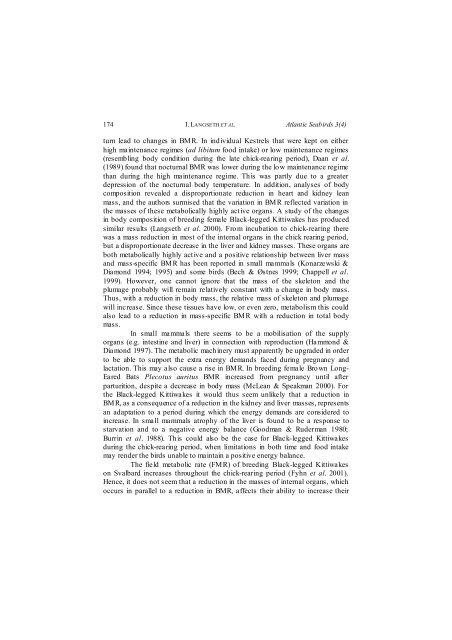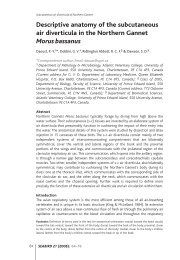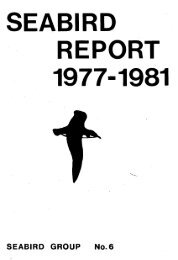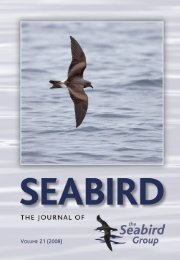Create successful ePaper yourself
Turn your PDF publications into a flip-book with our unique Google optimized e-Paper software.
174 I. LANGSETH ET AL. Atlantic <strong>Seabird</strong>s 3(4)<br />
turn lead to changes in BMR. In individual Kestrels that were kept on either<br />
high maintenance regimes (ad libitum food intake) or low maintenance regimes<br />
(resembling body condition during the late chick-rearing period), Daan et al.<br />
(1989) found that nocturnal BMR was lower during the low maintenance regime<br />
than during the high maintenance regime. This was partly due to a greater<br />
depression of the nocturnal body temperature. In addition, analyses of body<br />
composition revealed a disproportionate reduction in heart and kidney lean<br />
mass, and the authors surmised that the variation in BMR reflected variation in<br />
the masses of these metabolically highly active organs. A study of the changes<br />
in body composition of breeding female Black-legged Kittiwakes has produced<br />
similar results (Langseth et al. 2000). From incubation to chick-rearing there<br />
was a mass reduction in most of the internal organs in the chick rearing period,<br />
but a disproportionate decrease in the liver and kidney masses. <strong>The</strong>se organs are<br />
both metabolically highly active and a positive relationship between liver mass<br />
and mass-specific BMR has been reported in small mammals (Konarzewski &<br />
Diamond 1994; 1995) and some birds (Bech & Østnes 1999; Chappell et al.<br />
1999). However, one cannot ignore that the mass of the skeleton and the<br />
plumage probably will remain relatively constant with a change in body mass.<br />
Thus, with a reduction in body mass, the relative mass of skeleton and plumage<br />
will increase. Since these tissues have low, or even zero, metabolism this could<br />
also lead to a reduction in mass-specific BMR with a reduction in total body<br />
mass.<br />
In small mammals there seems to be a mobilisation of the supply<br />
organs (e.g. intestine and liver) in connection with reproduction (Hammond &<br />
Diamond 1997). <strong>The</strong> metabolic machinery must apparently be upgraded in order<br />
to be able to support the extra energy demands faced during pregnancy and<br />
lactation. This may also cause a rise in BMR. In breeding female Brown Long-<br />
Eared Bats Plecotus auritus BMR increased from pregnancy until after<br />
parturition, despite a decrease in body mass (McLean & Speakman 2000). For<br />
the Black-legged Kittiwakes it would thus seem unlikely that a reduction in<br />
BMR, as a consequence of a reduction in the kidney and liver masses, represents<br />
an adaptation to a period during which the energy demands are considered to<br />
increase. In small mammals atrophy of the liver is found to be a response to<br />
starvation and to a negative energy balance (Goodman & Ruderman 1980;<br />
Burrin et al. 1988). This could also be the case for Black-legged Kittiwakes<br />
during the chick-rearing period, when limitations in both time and food intake<br />
may render the birds unable to maintain a positive energy balance.<br />
<strong>The</strong> field metabolic rate (FMR) of breeding Black-legged Kittiwakes<br />
on Svalbard increases throughout the chick-rearing period (Fyhn et al. 2001).<br />
Hence, it does not seem that a reduction in the masses of internal organs, which<br />
occurs in parallel to a reduction in BMR, affects their ability to increase their








